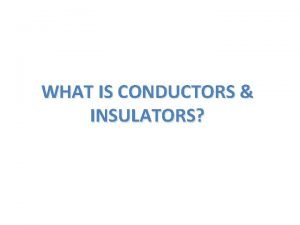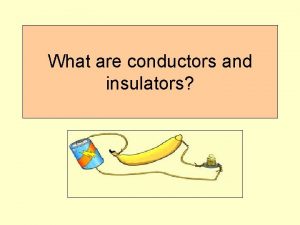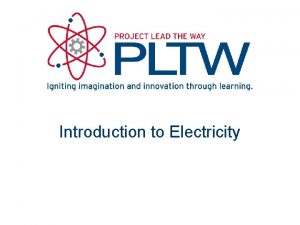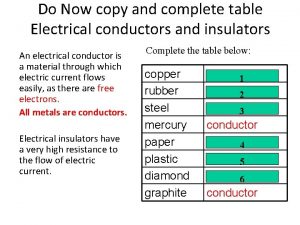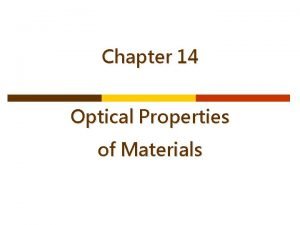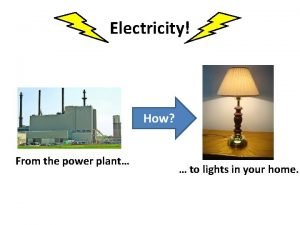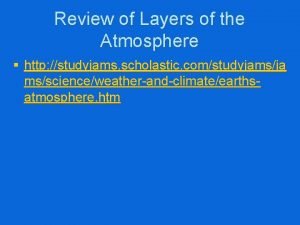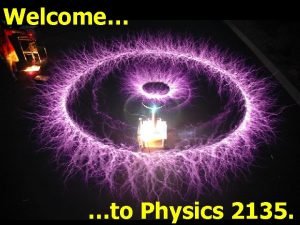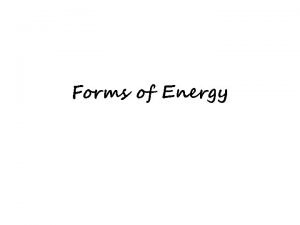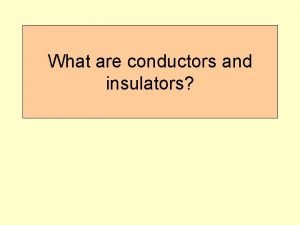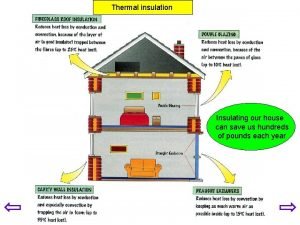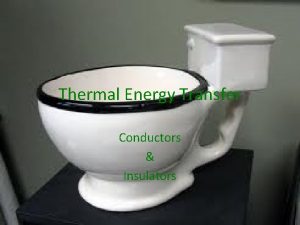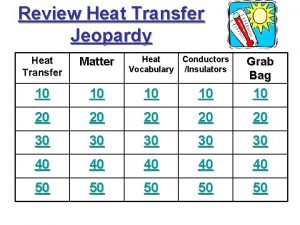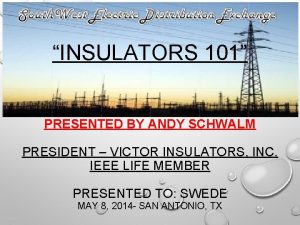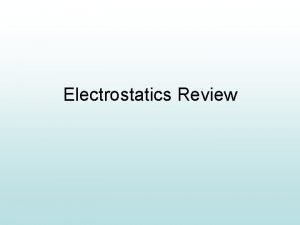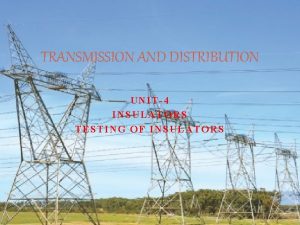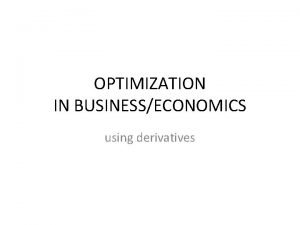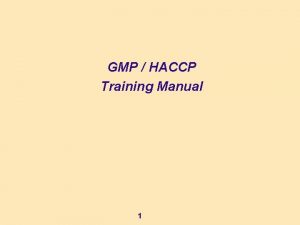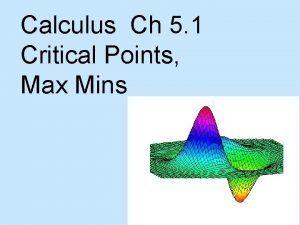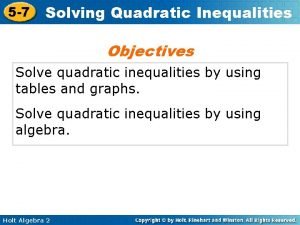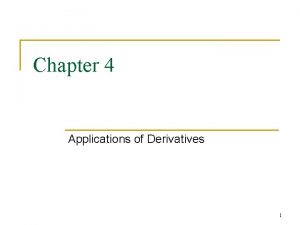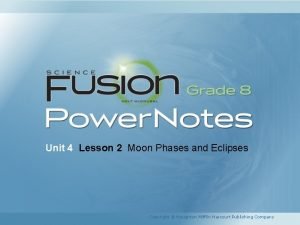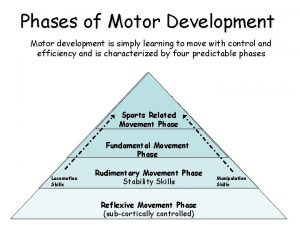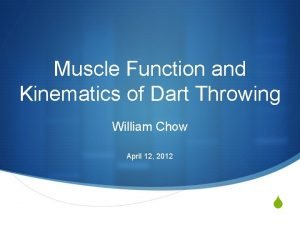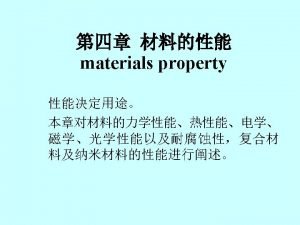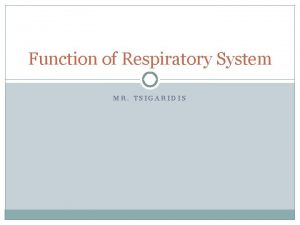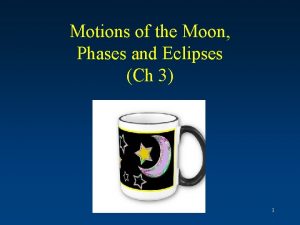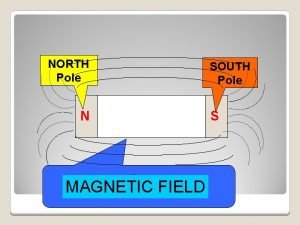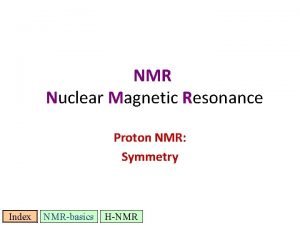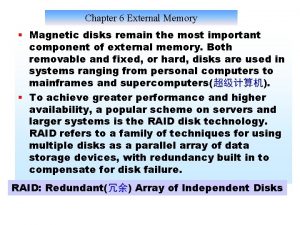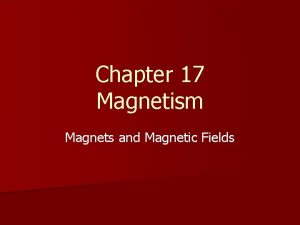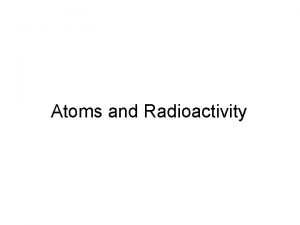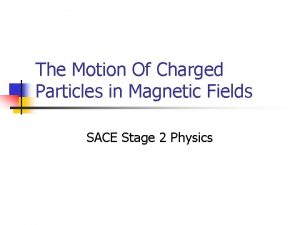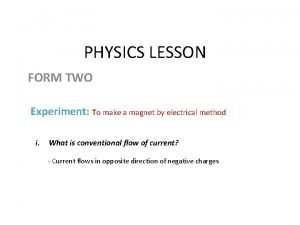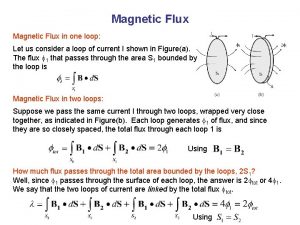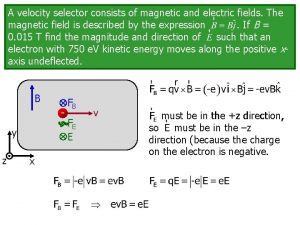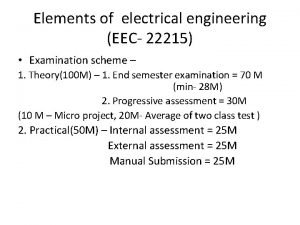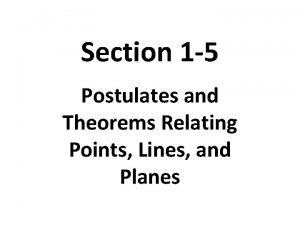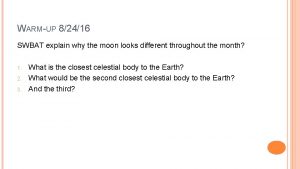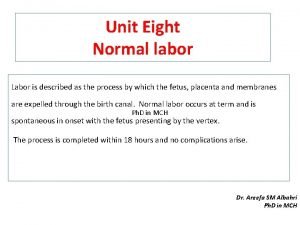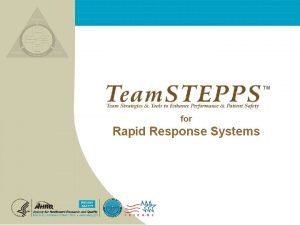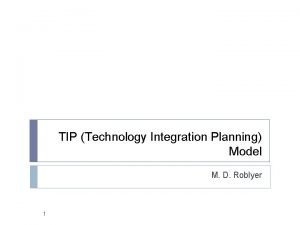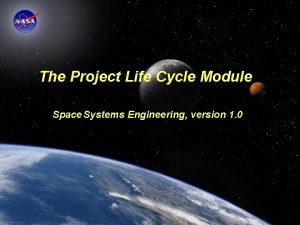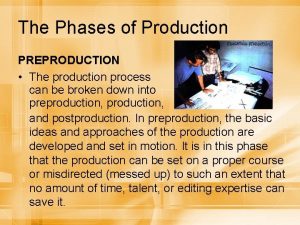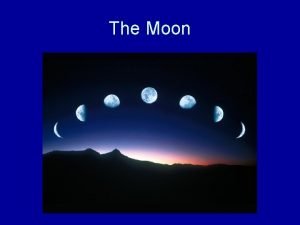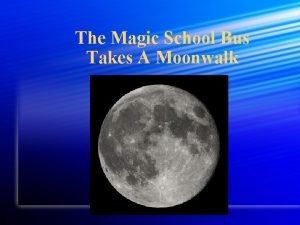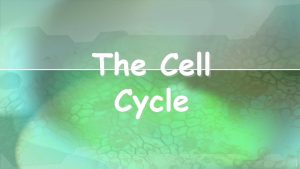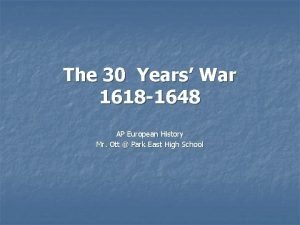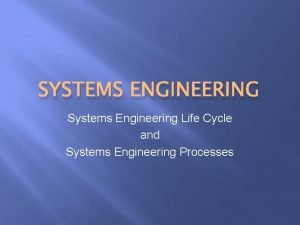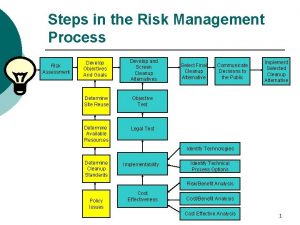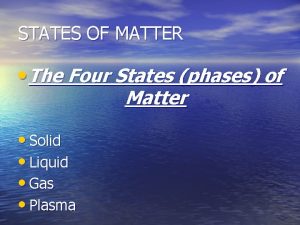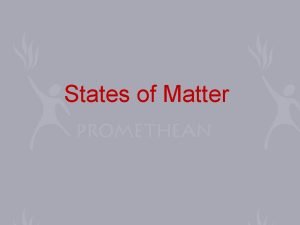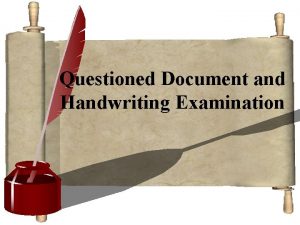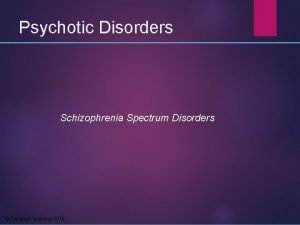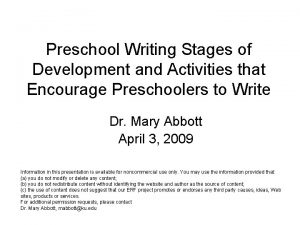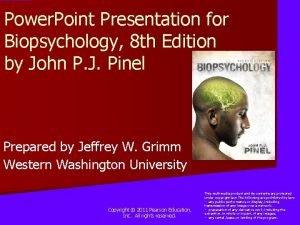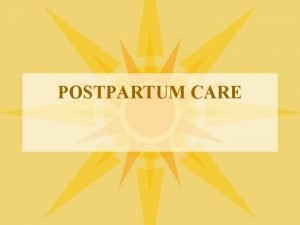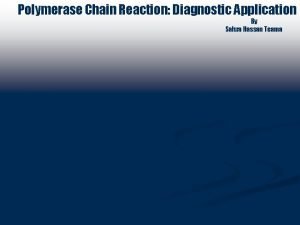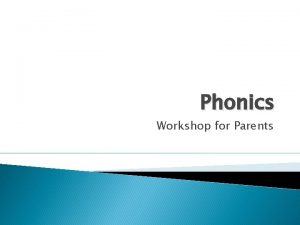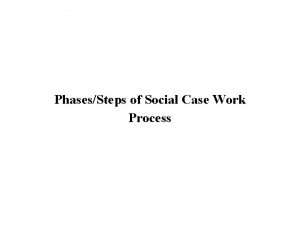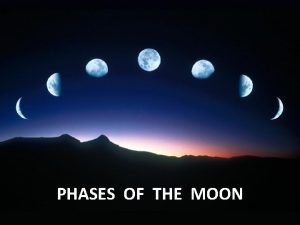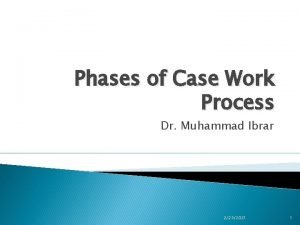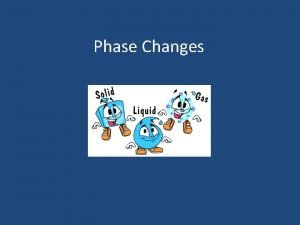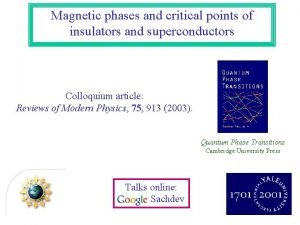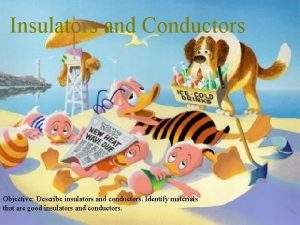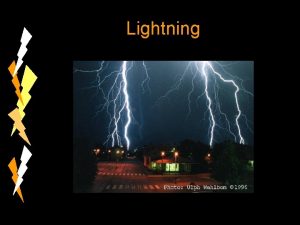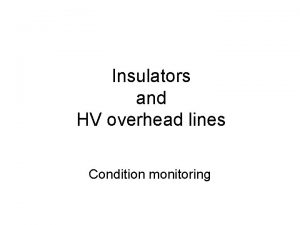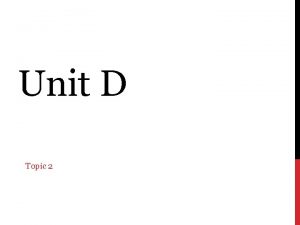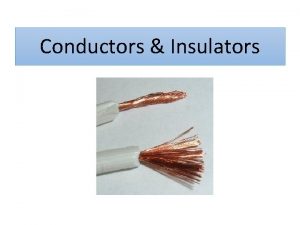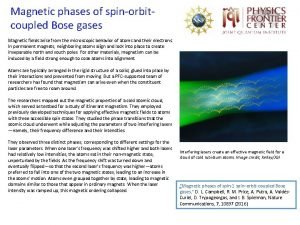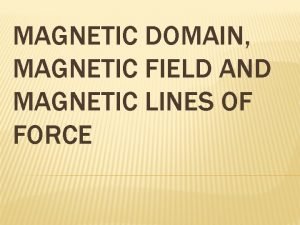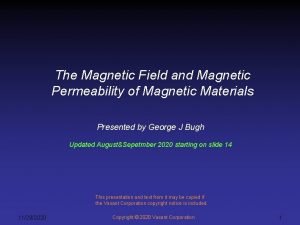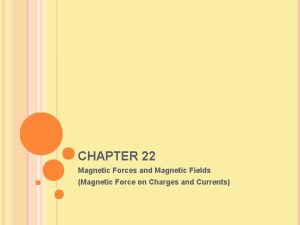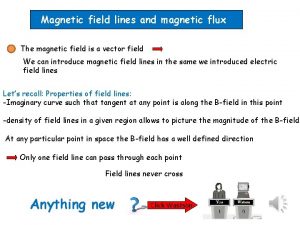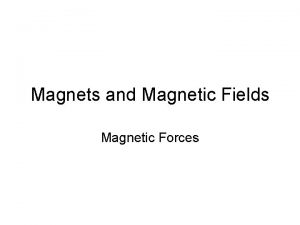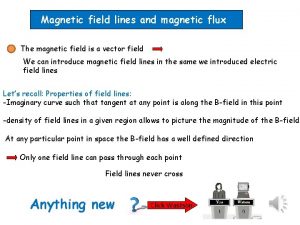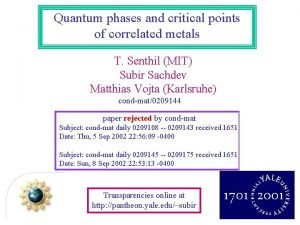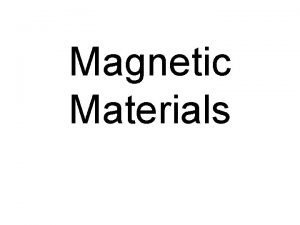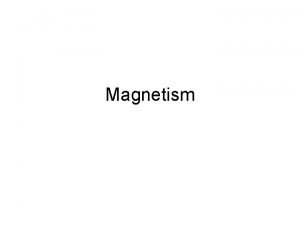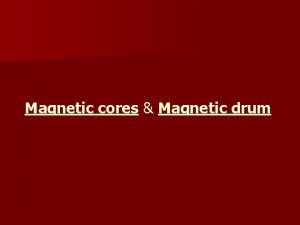Magnetic phases and critical points of insulators and





































































































- Slides: 101

Magnetic phases and critical points of insulators and superconductors • Colloquium article in Reviews of Modern Physics, July 2003, cond-mat/0211005. • cond-mat/0109419 Quantum Phase Transitions Cambridge University Press Talks online: Sachdev

What is a quantum phase transition ? Non-analyticity in ground state properties as a function of some control parameter g E E g True level crossing: Usually a first-order transition g Avoided level crossing which becomes sharp in the infinite volume limit: second-order transition

Why study quantum phase transitions ? T Quantum-critical gc g • Theory for a quantum system with strong correlations: describe phases on either side of gc by expanding in deviation from the quantum critical point. • Critical point is a novel state of matter without quasiparticle excitations • Critical excitations control dynamics in the wide quantum-critical region at non-zero temperatures. Important property of ground state at g=gc : temporal and spatial scale invariance; characteristic energy scale at other values of g:

Outline I. I. Quantum Ising Chain Quantum Ising chain II. Coupled Dimer Antiferromagnet Single order A. Coherent state path integral parameter. B. Quantum field theory near critical point III. Coupled dimer antiferromagnet in a magnetic field Bose condensation of “triplons” IV. Magnetic transitions in superconductors Quantum phase transition in a background Abrikosov flux lattice V. Antiferromagnets with an odd number of S=1/2 spins per unit cell. Class A: Compact U(1) gauge theory: collinear spins, bond order and confined spinons in d=2 Class B: Z 2 gauge theory: non-collinear spins, RVB, visons, topological order, and deconfined spinons VI. Conclusions Multiple order parameter s.

I. Quantum Ising Chain 2 Jg

Full Hamiltonian leads to entangled states at g of order unity

Weakly-coupled qubits Ground state: Lowest excited states: Coupling between qubits creates “flipped-spin” quasiparticle states at momentum p p Entire spectrum can be constructed out of multi-quasiparticle states

Weakly-coupled qubits Quasiparticle pole Structure holds to all orders in 1/g Three quasiparticle continuum ~3 D S. Sachdev and A. P. Young, Phys. Rev. Lett. 78, 2220 (1997)

Ground states: Strongly-coupled qubits Lowest excited states: domain walls Coupling between qubits creates new “domainwall” quasiparticle states at momentum p p

Strongly-coupled qubits Two domain-wall continuum Structure holds to all orders in g ~2 D S. Sachdev and A. P. Young, Phys. Rev. Lett. 78, 2220 (1997)

Entangled states at g of order unity “Flipped-spin” Quasiparticle weight Z A. V. Chubukov, S. Sachdev, and J. Ye, Phys. Rev. B 49, 11919 (1994) gc g Ferromagnetic moment N 0 P. Pfeuty Annals of Physics, 57, 79 (1970) gc g Excitation energy gap D

Critical coupling No quasiparticles --- dissipative critical continuum

Quasiclassical dynamics P. Pfeuty Annals of Physics, 57, 79 (1970) S. Sachdev and J. Ye, Phys. Rev. Lett. 69, 2411 (1992). S. Sachdev and A. P. Young, Phys. Rev. Lett. 78, 2220 (1997).

Outline I. Quantum Ising Chain II. Coupled Dimer Antiferromagnet Single order A. Coherent state path integral parameter. B. Quantum field theory near critical point III. Coupled dimer antiferromagnet in a magnetic field Bose condensation of “triplons” IV. Magnetic transitions in superconductors Quantum phase transition in a background Abrikosov flux lattice V. Antiferromagnets with an odd number of S=1/2 spins per unit cell. Class A: Compact U(1) gauge theory: collinear spins, bond order and confined spinons in d=2 Class B: Z 2 gauge theory: non-collinear spins, RVB, visons, topological order, and deconfined spinons VI. Conclusions Multiple order parameter s.

II. Coupled Dimer Antiferromagnet M. P. Gelfand, R. R. P. Singh, and D. A. Huse, Phys. Rev. B 40, 10801 -10809 (1989). N. Katoh and M. Imada, J. Phys. Soc. Jpn. 63, 4529 (1994). J. Tworzydlo, O. Y. Osman, C. N. A. van Duin, J. Zaanen, Phys. Rev. B 59, 115 (1999). M. Matsumoto, C. Yasuda, S. Todo, and H. Takayama, Phys. Rev. B 65, 014407 (2002). S=1/2 spins on coupled dimers

Square lattice antiferromagnet Experimental realization: Ground state has long-range magnetic (Neel) order Excitations: 2 spin waves (magnons)

Weakly coupled dimers Paramagnetic ground state

Weakly coupled dimers Excitation: S=1 triplon (exciton, spin collective mode) Energy dispersion away from antiferromagnetic wavevector

Weakly coupled dimers S=1/2 spinons are confined by a linear potential into a S=1 triplon

T=0 Neel order N 0 c Spin gap D 1 Neel state Quantum paramagnet d in cuprates ?

II. A Coherent state path integral Path integral for quantum spin fluctuations Key ingredient: Spin Berry Phases

II. A Coherent state path integral Path integral for quantum spin fluctuations Key ingredient: Spin Berry Phases

II. A Coherent state path integral See Chapter 13 of Quantum Phase Transitions, S. Sachdev, Cambridge University Press (1999). Path integral for a single spin Action for lattice antiferromagnet n and L vary slowly in space and time

Integrate out L and take the continuum limit Discretize spacetime into a cubic lattice

Integrate out L and take the continuum limit Discretize spacetime into a cubic lattice Berry phases can be neglected for coupled dimer antiferromagent (justified later) Quantum path integral for two-dimensional quantum antiferromagnet Partition function of a classical three-dimensional ferromagnet at a “temperature” g Quantum transition at l=lc is related to classical Curie transition at g=gc

II. B Quantum field theory for critical point l close to lc : use “soft spin” field 3 -component antiferromagnetic order parameter Oscillations of about zero (for l < lc ) spin-1 collective mode T=0 spectrum w

Critical coupling Dynamic spectrum at the critical point No quasiparticles --- dissipative critical continuum

Outline I. Quantum Ising Chain II. Coupled Dimer Antiferromagnet Single order A. Coherent state path integral parameter. B. Quantum field theory near critical point III. Coupled dimer antiferromagnet in a magnetic field III. Dimer Antiferromagnet in a magnetic field Bose condensation of “triplons” IV. Magnetic transitions in superconductors Quantum phase transition in a background Abrikosov flux lattice V. Antiferromagnets with an odd number of S=1/2 spins per unit cell. Class A: Compact U(1) gauge theory: collinear spins, bond order and confined spinons in d=2 Class B: Z 2 gauge theory: non-collinear spins, RVB, visons, topological order, and deconfined spinons VI. Conclusions Multiple order parameter s.

T=0 H SDW Pressure, exchange constant, …. Quantum critical point Evolution of phase diagram in a magnetic field Both states are insulators

Effect of a field on paramagnet Energy of zero momentum triplon states D 0 Bose-Einstein condensation of Sz=1 triplon H

III. Phase diagram in a magnetic field. H SDW gm. BH = D Spin singlet state with a spin gap 1/l 1 Tesla = 0. 116 me. V Related theory applies to double layer quantum Hall systems at n=2

III. Phase diagram in a magnetic field. H SDW gm. BH = D Spin singlet state with a spin gap 1/l 1 Tesla = 0. 116 me. V Related theory applies to double layer quantum Hall systems at n=2

III. Phase diagram in a magnetic field. H SDW gm. BH = D Spin singlet state with a spin gap 1/l 1 Tesla = 0. 116 me. V Related theory applies to double layer quantum Hall systems at n=2

III. Phase diagram in a magnetic field. M D H

III. Phase diagram in a magnetic field. 1 M At very large H, magnetization saturates D H

III. Phase diagram in a magnetic field. 1 M 1/2 D H Respulsive interactions between triplons can lead to magnetization plateau at any rational fraction

III. Phase diagram in a magnetic field. 1 Quantum transitions in and out of plateau are Bose-Einstein condensations of “extra/missing” triplons M 1/2 D H

Outline I. Quantum Ising Chain II. Coupled Dimer Antiferromagnet Single order A. Coherent state path integral parameter. B. Quantum field theory near critical point III. Coupled dimer antiferromagnet in a magnetic field Bose condensation of “triplons” IV. Magnetic transitions in superconductors Quantum phase transition in a background Abrikosov flux lattice V. Antiferromagnets with an odd number of S=1/2 spins per unit cell. Class A: Compact U(1) gauge theory: collinear spins, bond order and confined spinons in d=2 Class B: Z 2 gauge theory: non-collinear spins, RVB, visons, topological order, and deconfined spinons VI. Conclusions Multiple order parameter s.

SDW T=0 Pressure, carrier concentration, …. Quantum critical point We have so far considered the case where both states are insulators

SC+SDW T=0 SC Pressure, carrier concentration, …. Quantum critical point Now both sides have a “background” superconducting (SC) order

Interplay of SDW and SC order in the cuprates T=0 phases of LSCO ky /a 0 Insulator • /a Néel SDW 0 0. 02 0. 055 kx SC+SDW ~0. 12 -0. 14 SC (additional commensurability effects near =0. 125) J. M. Tranquada et al. , Phys. Rev. B 54, 7489 (1996). G. Aeppli, T. E. Mason, S. M. Hayden, H. A. Mook, J. Kulda, Science 278, 1432 (1997). S. Wakimoto, G. Shirane et al. , Phys. Rev. B 60, R 769 (1999). Y. S. Lee, R. J. Birgeneau, M. A. Kastner et al. , Phys. Rev. B 60, 3643 (1999) S. Wakimoto, R. J. Birgeneau, Y. S. Lee, and G. Shirane, Phys. Rev. B 63, 172501 (2001).

Interplay of SDW and SC order in the cuprates T=0 phases of LSCO ky /a 0 • • /a Néel SDW 0 0. 02 0. 055 Insulator kx SC+SDW ~0. 12 -0. 14 SC (additional commensurability effects near =0. 125) J. M. Tranquada et al. , Phys. Rev. B 54, 7489 (1996). G. Aeppli, T. E. Mason, S. M. Hayden, H. A. Mook, J. Kulda, Science 278, 1432 (1997). S. Wakimoto, G. Shirane et al. , Phys. Rev. B 60, R 769 (1999). Y. S. Lee, R. J. Birgeneau, M. A. Kastner et al. , Phys. Rev. B 60, 3643 (1999) S. Wakimoto, R. J. Birgeneau, Y. S. Lee, and G. Shirane, Phys. Rev. B 63, 172501 (2001).

Interplay of SDW and SC order in the cuprates T=0 phases of LSCO ky /a 0 Superconductor with Tc, min =10 K • • /a Néel SDW 0 0. 02 0. 055 kx SC+SDW ~0. 12 -0. 14 SC (additional commensurability effects near =0. 125) J. M. Tranquada et al. , Phys. Rev. B 54, 7489 (1996). G. Aeppli, T. E. Mason, S. M. Hayden, H. A. Mook, J. Kulda, Science 278, 1432 (1997). S. Wakimoto, G. Shirane et al. , Phys. Rev. B 60, R 769 (1999). Y. S. Lee, R. J. Birgeneau, M. A. Kastner et al. , Phys. Rev. B 60, 3643 (1999) S. Wakimoto, R. J. Birgeneau, Y. S. Lee, and G. Shirane, Phys. Rev. B 63, 172501 (2001).

Collinear magnetic (spin density wave) order Collinear spins

Interplay of SDW and SC order in the cuprates T=0 phases of LSCO ky /a 0 Superconductor with Tc, min =10 K • • /a Néel SDW 0 0. 02 0. 055 kx SC+SDW ~0. 12 -0. 14 SC Use simplest assumption of a direct second-order quantum phase transition between SC and SC+SDW phases

Magnetic transition in a d-wave superconductor Otherwise, new theory of coupled excitons and nodal quasiparticles L. Balents, M. P. A. Fisher, C. Nayak, Int. J. Mod. Phys. B 12, 1033 (1998).

Magnetic transition in a d-wave superconductor Similar terms present in action for SDW ordering in the insulator Coupling to the S=1/2 Bogoliubov quasiparticles of the d-wave superconductor Trilinear “Yukawa” coupling is prohibited unless ordering wavevector is fine-tuned.

Neutron scattering measurements of dynamic spin correlations of the superconductor (SC) in a magnetic field B. Lake, G. Aeppli, K. N. Clausen, D. F. Mc. Morrow, K. Lefmann, N. E. Hussey, N. Mangkorntong, M. Nohara, H. Takagi, T. E. Mason, and A. Schröder, Science 291, 1759 (2001).

Neutron scattering measurements of dynamic spin correlations of the superconductor (SC) in a magnetic field B. Lake, G. Aeppli, K. N. Clausen, D. F. Mc. Morrow, K. Lefmann, N. E. Hussey, N. Mangkorntong, M. Nohara, H. Takagi, T. E. Mason, and A. Schröder, Science 291, 1759 (2001). D. P. Arovas, A. J. Berlinsky, C. Kallin, and S. -C. Zhang, Phys. Rev. Lett. 79, 2871 (1997) proposed static magnetism localized within vortex cores, but signal was much larger than anticipated.

Dominant effect of magnetic field: Abrikosov flux lattice

Effect of magnetic field on SDW+SC to SC transition (extreme Type II superconductivity) Quantum theory for dynamic and critical spin fluctuations Static Ginzburg-Landau theory for non-critical superconductivity

Triplon wavefunction in bare potential V 0(x) Energy Spin gap D 0 x Vortex cores

Energy Spin gap D 0 x Vortex cores

Phase diagram of SC and SDW order in a magnetic field E. Demler, S. Sachdev, and Ying Zhang, Phys. Rev. Lett. 87, 067202 (2001).

Phase diagram of SC and SDW order in a magnetic field E. Demler, S. Sachdev, and Ying Zhang, Phys. Rev. Lett. 87, 067202 (2001).

Structure of long-range SDW order in SC+SDW phase E. Demler, S. Sachdev, and Ying Zhang, Phys. Rev. Lett. 87, 067202 (2001). Magnetic order parameter s – sc = -0. 3

Interplay of SDW and SC order in the cuprates T=0 phases of LSCO H ky /a 0 Superconductor with Tc, min =10 K • • /a Néel SDW 0 0. 02 0. 055 kx SC+SDW ~0. 12 -0. 14 SC Use simplest assumption of a direct second-order quantum phase transition between SC and SC+SDW phases Follow intensity of elastic Bragg spots in a magnetic field

B. Lake, H. M. Rønnow, N. B. Christensen, G. Aeppli, K. Lefmann, D. F. Mc. Morrow, P. Vorderwisch, P. Smeibidl, N. Mangkorntong, T. Sasagawa, M. Nohara, H. Takagi, T. E. Mason, Nature, 415, 299 (2002). See also S. Katano, M. Sato, K. Yamada, T. Suzuki, and T. Fukase, Phys. Rev. B 62, R 14677 (2000).

Phase diagram of a superconductor in a magnetic field Neutron scattering observation of SDW order enhanced by superflow. Prediction: SDW fluctuations enhanced by superflow and bond order pinned by vortex cores (no spins in vortices). Should be observable in STM K. Park and S. Sachdev Physical Review B 64, 184510 (2001); E. Demler, S. Sachdev, and Ying Zhang, Phys. Rev. Lett. 87, 067202 (2001). Y. Zhang, E. Demler and S. Sachdev, Physical Review B 66, 094501 (2002).

Vortex-induced LDOS of Bi 2 Sr 2 Ca. Cu 2 O 8+d integrated from 1 me. V to 12 me. V Our interpretation: LDOS modulations are signals of bond order of period 4 revealed in vortex halo 7 p. A b 0 p. A 100Å J. Hoffman E. W. Hudson, K. M. Lang, V. Madhavan, S. H. Pan, H. Eisaki, S. Uchida, and J. C. Davis, Science 295, 466 (2002). See also: S. A. Kivelson, E. Fradkin, V. Oganesyan, I. P. Bindloss, J. M. Tranquada, A. Kapitulnik, and C. Howald, condmat/0210683.

Fourier Transform of Vortex-Induced LDOS map K-space locations of vortex induced LDOS K-space locations of Bi and Cu atoms Distances in k –space have units of 2 p/a 0 a 0=3. 83 Å is Cu-Cu distance J. Hoffman et al. Science, 295, 466 (2002).

Spectral properties of the STM signal are sensitive to the microstructure of the charge order Theoretical modeling shows that this spectrum is best obtained by a modulation of bond variables, such as the exchange, kinetic or pairing energies. Measured energy dependence of the Fourier component of the density of states which modulates with a period of 4 lattice spacings M. Vojta, Phys. Rev. B 66, 104505 (2002); C. Howald, H. Eisaki, N. Kaneko, and A. Kapitulnik, Phys. Rev. B 67, 014533 (2003). D. Podolsky, E. Demler, K. Damle, and B. I. Halperin, Phys. Rev. B in press, condmat/0204011

Outline I. Quantum Ising Chain II. Coupled Dimer Antiferromagnet Single order A. Coherent state path integral parameter. B. Quantum field theory near critical point III. Coupled dimer antiferromagnet in a magnetic field Bose condensation of “triplons” IV. Magnetic transitions in superconductors Quantum phase transition in a background Abrikosov flux lattice V. V. Antiferromagnets with an odd number of S=1/2 spins per unit cell. Class. AA: Compact U(1) gauge theory: collinear spins, Class bond order and confined spinons in d=2 Class B: Z 2 gauge theory: non-collinear spins, RVB, visons, topological order, and deconfined spinons VI. Conclusions Multiple order parameter s.

V. Order in Mott insulators Magnetic order Class A. Collinear spins

V. Order in Mott insulators Magnetic order Class A. Collinear spins Key property Order specified by a single vector N. Quantum fluctuations leading to loss of magnetic order should produce a paramagnetic state with a vector (S=1) quasiparticle excitation.

Class A: Collinear spins and compact U(1) gauge theory Write down path integral for quantum spin fluctuations Key ingredient: Spin Berry Phases

Class A: Collinear spins and compact U(1) gauge theory Write down path integral for quantum spin fluctuations Key ingredient: Spin Berry Phases

Class A: Collinear spins and compact U(1) gauge theory S=1/2 square lattice antiferromagnet with non-nearest neighbor exchange Include Berry phases after discretizing coherent state path integral on a cubic lattice in spacetime



Change in choice of n 0 is like a “gauge transformation” g is the oriented area of the spherical triangle formed ( a by na and the two choices for n 0 ). The area of the triangle is uncertain modulo 4 , and the action is invariant under These principles strongly constrain the effective action for Aam which provides description of the large g phase

Simplest large g effective action for the Aam This theory can be reliably analyzed by a duality mapping. d=2: The gauge theory is always in a confining phase and confining there is bond order in the ground state. d=3: A deconfined phase with a gapless “photon” is possible. N. Read and S. Sachdev, Phys. Rev. Lett. 62, 1694 (1989). S. Sachdev and R. Jalabert, Mod. Phys. Lett. B 4, 1043 (1990). K. Park and S. Sachdev, Phys. Rev. B 65, 220405 (2002).


For large e 2 , low energy height configurations are in exact one-toone correspondence with dimer coverings of the square lattice 2+1 dimensional height model is the path integral of the Quantum Dimer Model There is no roughening transition for three dimensional interfaces, which are smooth for all couplings There is a definite average height of the interface Ground state has bond order.

V. Order in Mott insulators Paramagnetic states Class A. Bond order and spin excitons in d=2 S=1/2 spinons are confined by a linear potential into a S=1 spin triplon Spontaneous bond-order leads to vector S=1 spin excitations N. Read and S. Sachdev, Phys. Rev. Lett. 62, 1694 (1989).

Bond order in a frustrated S=1/2 XY magnet A. W. Sandvik, S. Daul, R. R. P. Singh, and D. J. Scalapino, Phys. Rev. Lett. 89, 247201 (2002) First large scale numerical study of the destruction of Neel order in a S=1/2 antiferromagnet with full square lattice symmetry g=

Outline I. Quantum Ising Chain II. Coupled Dimer Antiferromagnet Single order A. Coherent state path integral parameter. B. Quantum field theory near critical point III. Coupled dimer antiferromagnet in a magnetic field Bose condensation of “triplons” IV. Magnetic transitions in superconductors Quantum phase transition in a background Abrikosov flux lattice V. with an odd number V. Antiferromagnets with an odd number of S=1/2 spins per unit cell. Class A: Compact U(1) gauge theory: collinear spins, bond order and confined spinons in d=2 Class B: Z Class B 2 gauge theory: non-collinear spins, RVB, visons, topological order, and deconfined spinons VI. Conclusions Multiple order parameter s.

V. B Order in Mott insulators Magnetic order Class B. Noncollinear spins (B. I. Shraiman and E. D. Siggia, Phys. Rev. Lett. 61, 467 (1988))

V. B Order in Mott insulators Magnetic order Class B. Noncollinear spins A. V. Chubukov, S. Sachdev, and T. Senthil Phys. Rev. Lett. 72, 2089 (1994)

V. B Order in Mott insulators Magnetic order Class B. Noncollinear spins Vortices associated with p 1(S 3/Z 2)=Z 2 (visons) (A) North pole y (B) South pole S 3 (B) (A) x Such vortices (visons) can also be defined in the phase in which spins are “quantum disordered”. A Z 2 spin liquid with deconfined spinons must have visons supressed N. Read and S. Sachdev, Phys. Rev. Lett. 66, 1773 (1991)

Model effective action and phase diagram (Derivation using Schwinger bosons on a quantum antiferromagnet: S. Sachdev and N. Read, Int. J. Mod. Phys. B 5, 219 (1991)). First order transition Magnetically ordered Confined spinons Free spinons and topological order P. E. Lammert, D. S. Rokhsar, and J. Toner, Phys. Rev. Lett. 70, 1650 (1993) ; Phys. Rev. E 52, 1778 (1995). (For nematic liquid crystals)

V. B Order in Mott insulators Paramagnetic states Class B. Topological order and deconfined spinons A topologically ordered state in which vortices associated with 1(S 3/Z 2)=Z 2 [“visons”] are gapped out. This is an RVB state with deconfined S=1/2 spinons za N. Read and S. Sachdev, Phys. Rev. Lett. 66, 1773 (1991). X. G. Wen, Phys. Rev. B 44, 2664 (1991). A. V. Chubukov, T. Senthil and S. S. , Phys. Rev. Lett. 72, 2089 (1994). T. Senthil and M. P. A. Fisher, Phys. Rev. B 62, 7850 (2000). P. Fazekas and P. W. Anderson, Phil Mag 30, 23 (1974). G. Misguich and C. Lhuillier, Eur. Phys. J. B 26, 167 (2002). R. Moessner and S. L. Sondhi, Phys. Rev. Lett. 86, 1881 (2001). Recent experimental realization: Cs 2 Cu. Cl 4 R. Coldea, D. A. Tennant, A. M. Tsvelik, and Z. Tylczynski, Phys. Rev. Lett. 86, 1335 (2001).

V. B Order in Mott insulators Paramagnetic states Class B. Topological order and deconfined spinons Direct description of topological order with valence bonds Number of valence bonds cutting line is conserved modulo 2. Changing sign of each such bond does not modify state. This is equivalent to a Z 2 gauge transformation with on sites to the right of dashed line. D. Rokhsar and S. A. Kivelson, Phys. Rev. Lett. 61, 2376 (1988); N. Read and B. Chakraborty, Phys. Rev. B 40, 7133 (1989).

V. B Order in Mott insulators Paramagnetic states Class B. Topological order and deconfined spinons Direct description of topological order with valence bonds Number of valence bonds cutting line is conserved modulo 2. Changing sign of each such bond does not modify state. This is equivalent to a Z 2 gauge transformation with on sites to the right of dashed line. D. Rokhsar and S. A. Kivelson, Phys. Rev. Lett. 61, 2376 (1988); N. Read and B. Chakraborty, Phys. Rev. B 40, 7133 (1989).

V. B Order in Mott insulators Paramagnetic states Class B. Topological order and deconfined spinons Direct description of topological order with valence bonds Terminating the line creates a plaquette with Z 2 flux at the X -- a vison. X D. Rokhsar and S. A. Kivelson, Phys. Rev. Lett. 61, 2376 (1988); N. Read and B. Chakraborty, Phys. Rev. B 40, 7133 (1989).

Effect of flux-piercing on a topologically ordered quantum paramagnet N. E. Bonesteel, Phys. Rev. B 40, 8954 (1989). G. Misguich, C. Lhuillier, M. Mambrini, and P. Sindzingre, Eur. Phys. J. B 26, 167 (2002). F Ly Lx-2 Lx-1 Lx 1 2 3

Effect of flux-piercing on a topologically ordered quantum paramagnet N. E. Bonesteel, Phys. Rev. B 40, 8954 (1989). G. Misguich, C. Lhuillier, M. Mambrini, and P. Sindzingre, Eur. Phys. J. B 26, 167 (2002). vison Ly Lx-2 Lx-1 Lx 1 2 3

VI. Conclusions I. Quantum Ising Chain II. Coupled Dimer Antiferromagnet Single order A. Coherent state path integral parameter. B. Quantum field theory near critical point III. Coupled dimer antiferromagnet in a magnetic field Bose condensation of “triplons” IV. Magnetic transitions in superconductors Quantum phase transition in a background Abrikosov flux lattice V. Antiferromagnets with an odd number of S=1/2 spins per unit cell. Class A: Compact U(1) gauge theory: collinear spins, bond order and confined spinons in d=2 Class B: Z 2 gauge theory: non-collinear spins, RVB, visons, topological order, and deconfined spinons VI. Cuprates are best understood as doped class A Mott insulators. Multiple order parameter s.

Competing order parameters in the cuprate superconductors 1. Pairing order of BCS theory (SC) (Bose-Einstein) condensation of d-wave Cooper pairs Orders (possibly fluctuating) associated with proximate Mott insulator in class A 2. Collinear magnetic order (CM) 3. Bond/charge/stripe order (B) (couples strongly to half-breathing phonons) S. Sachdev and N. Read, Int. J. Mod. Phys. B 5, 219 (1991). M. Vojta and S. Sachdev, Phys. Rev. Lett. 83, 3916 (1999); M. Vojta, Y. Zhang, and S. Sachdev, Phys. Rev. B 62, 6721 (2000); M. Vojta, Phys. Rev. B 66, 104505 (2002).

Evidence cuprates are in class A

Evidence cuprates are in class A • Neutron scattering shows collinear magnetic order co-existing with superconductivity J. M. Tranquada et al. , Phys. Rev. B 54, 7489 (1996). Y. S. Lee, R. J. Birgeneau, M. A. Kastner et al. , Phys. Rev. B 60, 3643 (1999). S. Wakimoto, R. J. Birgeneau, Y. S. Lee, and G. Shirane, Phys. Rev. B 63, 172501 (2001).

Evidence cuprates are in class A • Neutron scattering shows collinear magnetic order co-existing with superconductivity • Proximity of Z 2 Mott insulators requires stable hc/e vortices, vison gap, and Senthil flux memory effect S. Sachdev, Physical Review B 45, 389 (1992) N. Nagaosa and P. A. Lee, Physical Review B 45, 966 (1992) T. Senthil and M. P. A. Fisher, Phys. Rev. Lett. 86, 292 (2001). D. A. Bonn, J. C. Wynn, B. W. Gardner, Y. -J. Lin, R. Liang, W. N. Hardy, J. R. Kirtley, and K. A. Moler, Nature 414, 887 (2001). J. C. Wynn, D. A. Bonn, B. W. Gardner, Y. -J. Lin, R. Liang, W. N. Hardy, J. R. Kirtley, and K. A. Moler, Phys. Rev. Lett. 87, 197002 (2001).

Evidence cuprates are in class A • Neutron scattering shows collinear magnetic order co-existing with superconductivity • Proximity of Z 2 Mott insulators requires stable hc/e vortices, vison gap, and Senthil flux memory effect • Non-magnetic impurities in underdoped cuprates acquire a S=1/2 moment

Effect of static non-magnetic impurities (Zn or Li) Zn Zn Zn Spinon confinement implies that free S=1/2 moments form near each impurity Zn

Spatially resolved NMR of Zn/Li impurities in the superconducting state 7 Li NMR below T Inverse local susceptibilty in YBCO c J. Bobroff, H. Alloul, W. A. Mac. Farlane, P. Mendels, N. Blanchard, G. Collin, and J. -F. Marucco, Phys. Rev. Lett. 86, 4116 (2001). A. M Finkelstein, V. E. Kataev, E. F. Kukovitskii, G. B. Teitel’baum, Physica C 168, 370 (1990).

Evidence cuprates are in class A • Neutron scattering shows collinear magnetic order co-existing with superconductivity • Proximity of Z 2 Mott insulators requires stable hc/e vortices, vison gap, and Senthil flux memory effect • Non-magnetic impurities in underdoped cuprates acquire a S=1/2 moment

Evidence cuprates are in class A • Neutron scattering shows collinear magnetic order co-existing with superconductivity • Proximity of Z 2 Mott insulators requires stable hc/e vortices, vison gap, and Senthil flux memory effect • Non-magnetic impurities in underdoped cuprates acquire a S=1/2 moment • Tests of phase diagram in a magnetic field

Phase diagram of a superconductor in a magnetic field Neutron scattering observation of SDW order enhanced by superflow. E. Demler, S. Sachdev, and Ying Zhang, Phys. Rev. Lett. 87, 067202 (2001).

Phase diagram of a superconductor in a magnetic field Neutron scattering observation of SDW order enhanced by superflow. Possible STM observation of predicted bond order in halo around vortices K. Park and S. Sachdev Physical Review B 64, 184510 (2001); E. Demler, S. Sachdev, and Ying Zhang, Phys. Rev. Lett. 87, 067202 (2001). Y. Zhang, E. Demler and S. Sachdev, Physical Review B 66, 094501 (2002).

VI. Doping Class A Doping a paramagnetic bond-ordered Mott insulator systematic Sp(N) theory of translational symmetry breaking, while preserving spin rotation invariance. T=0 d-wave superconductor Superconductor with co-existing bond-order Mott insulator with bond-order S. Sachdev and N. Read, Int. J. Mod. Phys. B 5, 219 (1991).

Vertical axis is any microscopic parameter which suppresses CM order A phase diagram Microscopic theory for the interplay of bond (B) and d-wave superconducting (SC) order • Pairing order of BCS theory (SC) • Collinear magnetic order (CM) • Bond order (B) S. Sachdev and N. Read, Int. J. Mod. Phys. B 5, 219 (1991). M. Vojta and S. Sachdev, Phys. Rev. Lett. 83, 3916 (1999); M. Vojta, Y. Zhang, and S. Sachdev, Phys. Rev. B 62, 6721 (2000); M. Vojta, Phys. Rev. B 66, 104505 (2002).
 Critical semi critical and non critical instruments
Critical semi critical and non critical instruments Spaulding classification of medical devices ppt
Spaulding classification of medical devices ppt Coercivity
Coercivity Unit of magnetic flux is weber
Unit of magnetic flux is weber Magnetic moment and magnetic field relation
Magnetic moment and magnetic field relation Magnetic force particle
Magnetic force particle Examples of conductors
Examples of conductors Pictures of insulators and conductors
Pictures of insulators and conductors What are conductors and insulators
What are conductors and insulators Table of conductors and insulators
Table of conductors and insulators Opacity and translucency in insulators
Opacity and translucency in insulators Bad conductor of electricity
Bad conductor of electricity Studyjams heat
Studyjams heat Conductors and insulators
Conductors and insulators Five forms of energy
Five forms of energy Brand positioning bulls eye
Brand positioning bulls eye Point of difference and point of parity
Point of difference and point of parity Is scissors a conductor or insulator
Is scissors a conductor or insulator Thermal insulation home
Thermal insulation home Great insulators
Great insulators Jeopardy conductor
Jeopardy conductor Victor insulators inc
Victor insulators inc Which sentence best characterizes electric insulators?
Which sentence best characterizes electric insulators? Testing of insulators
Testing of insulators Types of critical points
Types of critical points Haccp training materials
Haccp training materials Examples of critical control points
Examples of critical control points Calculus critical points
Calculus critical points Examples of critical control points
Examples of critical control points 5 example of quadratic inequalities
5 example of quadratic inequalities Relative extreme values
Relative extreme values Critical decision points
Critical decision points Critical reading meaning
Critical reading meaning Lesson 2 moon phases and eclipses answer key
Lesson 2 moon phases and eclipses answer key Rudimentary movement phase
Rudimentary movement phase Vx=vcosθ
Vx=vcosθ Stress curve and phases
Stress curve and phases Frontend and backend of compiler
Frontend and backend of compiler Pulmonary ventilation consists of two cyclic phases
Pulmonary ventilation consists of two cyclic phases Facts about first quarter moon
Facts about first quarter moon Phases of system analysis and design
Phases of system analysis and design Moon phases and eclipses
Moon phases and eclipses Enumerate the rice plant growth and development stages
Enumerate the rice plant growth and development stages 21lwuy8i6hw -site:youtube.com
21lwuy8i6hw -site:youtube.com Magnetic flux characteristics
Magnetic flux characteristics Pople notation examples
Pople notation examples Learning: module 26: magnetic forces and fields
Learning: module 26: magnetic forces and fields Scrap heap magnet diagram
Scrap heap magnet diagram A system has 12 magnetic tape drives and 3 processes
A system has 12 magnetic tape drives and 3 processes Magnetic disk read and write mechanism
Magnetic disk read and write mechanism Force exerted by magnets
Force exerted by magnets Nuclear notation
Nuclear notation Electric field and magnetic field difference
Electric field and magnetic field difference Kinetic energy magnetic field
Kinetic energy magnetic field Distinguish between magnetic and nonmagnetic materials
Distinguish between magnetic and nonmagnetic materials Magnetic flux and inductance
Magnetic flux and inductance A velocity selector consists of electric and magnetic
A velocity selector consists of electric and magnetic Eec micro project pdf
Eec micro project pdf Dot and cross in magnetic field
Dot and cross in magnetic field Electric currents and magnetic fields
Electric currents and magnetic fields Visualizing magnetic field
Visualizing magnetic field Magnetic field
Magnetic field Basic electrical engineering kulshreshtha
Basic electrical engineering kulshreshtha Postulate 1-5
Postulate 1-5 Phases of labour
Phases of labour Moon phases when the sun is on the left
Moon phases when the sun is on the left Real contractions vs false labor
Real contractions vs false labor Steps in community development
Steps in community development Phases of dental treatment planning
Phases of dental treatment planning Ipassthebaton
Ipassthebaton Technology integration planning model
Technology integration planning model Nasa project life-cycle process flow poster
Nasa project life-cycle process flow poster Phases of production
Phases of production What are tides and how are they caused
What are tides and how are they caused Magic school bus takes a moonwalk
Magic school bus takes a moonwalk Four phases of french revolution
Four phases of french revolution J shaped muscular sac
J shaped muscular sac Pathway of food from mouth to anus
Pathway of food from mouth to anus Five phases of the cell cycle
Five phases of the cell cycle 30 years war phases
30 years war phases Systems engineering life cycle
Systems engineering life cycle Dlc117: the risk management (rm) process
Dlc117: the risk management (rm) process Four phases of matter
Four phases of matter 4 phases of matter
4 phases of matter Stages of counseling
Stages of counseling Monitoring and coaching form for teachers
Monitoring and coaching form for teachers What are the phases of handwriting examination?
What are the phases of handwriting examination? Quality and safety education for nurses
Quality and safety education for nurses Qsen standards
Qsen standards Trade promotion management phases
Trade promotion management phases Phases of schizophrenia
Phases of schizophrenia Opt model
Opt model Stages of writing preschool
Stages of writing preschool Ionotropic vs metabotropic receptors
Ionotropic vs metabotropic receptors Phases of postpartum psychological adaptation
Phases of postpartum psychological adaptation Pcr
Pcr Book bands linked to phonic phases
Book bands linked to phonic phases Case work process
Case work process Moon phases
Moon phases Social case work process
Social case work process Phases changes of matter
Phases changes of matter Phases of nurse patient relationship
Phases of nurse patient relationship






